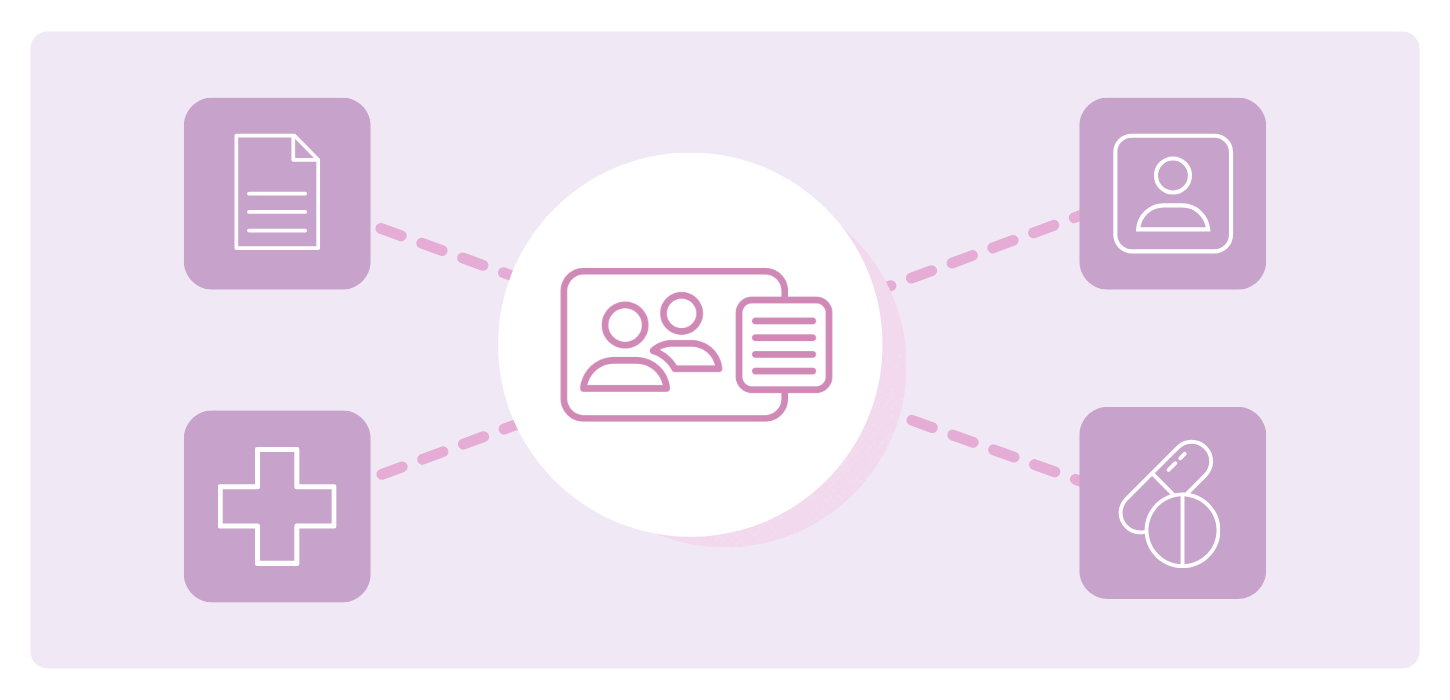At A Glance
Identity resolution unifies fragmented IDs into complete customer profiles, helping companies understand their audiences and deliver personalized, privacy-compliant experiences in a cookie-light world. With Experian’s AI-powered identity resolution solution, marketers gain the scale, accuracy, and compliance to compete while making marketing more human.In this article…
Every marketer has seen it: a customer browses reviews on a laptop, adds items to a cart on mobile, then “disappears.” In reality, they just likely switched devices or logged in with a different email. Identity resolution connects these scattered signals into a single profile so you never lose sight of the customer journey.
Identity resolution is what helps you keep track of customers who bounce around.
Connecting scattered signals into a single customer profile can help you deliver seamless experiences, meet strengthening privacy standards, turn first-party data into measurable results, and fuel better customer analytics.
See our identity resolution solution in action
What is identity resolution?
Identity resolution is the process of pulling together the different identifiers a customer uses and connecting them to a single profile. Without it, you’re left with an incomplete picture of the customer — like a cart tied to one email, an app login tied to another device, or a loyalty swipe that never links back to the same person.

Common identifiers include:
- Cookies: Short-lived browser data
- Emails: Plain-text and hashed
- Device IDs: Mobile advertising IDs (MAIDs) or app-based identifiers
- Loyalty IDs: Program numbers that tie online and offline activity
- Hashed PII: Personally identifiable information (PII) encrypted for privacy
Ultimately, identity resolution can help you recognize the same customer wherever they engage.
Why does identity resolution matter now?
Marketers face incomplete views, data silos, privacy regulations, and shrinking visibility:
- Rising consumer expectations: People want seamless, personalized journeys across touchpoints.
- Privacy-first environment: Consumer privacy legislation (like the GDPR, CCPA, GLBA, FCRA, and new state laws) makes compliance non-negotiable.
- Signal loss: The decline of cookies, MAIDs, and walled gardens are pushing brands toward first-party data.
Experian utilizes AI and machine learning to fill these gaps, predict behaviors, and connect signals across devices — providing marketers with a clear, privacy-safe view of their customers, even when traditional identifiers are missing.
In this environment, identity resolution matters because it gives marketers a way to deliver seamless, personalized customer experiences and engage audiences effectively while respecting their privacy. It’s the basis for turning consented first-party data into measurable marketing outcomes without sacrificing trust.
Why is identity resolution critical in a privacy-first world?
Even as cookies linger, marketers have already shifted their strategies to rely on first-party data, where choice and transparency are the baseline expectation. At Experian, our long history as a regulated data steward makes us a uniquely capable and trusted partner for managing modern compliance expectations. Our identity resolution solutions maximize the value of permission-based data while meeting consumer demand for privacy, personalization, and control.
Struggling with scattered customer data? Experian makes identity resolution seamless
How does identity resolution help brands?
Identity resolution turns fragmented signals into unified profiles that drive personalization, efficiency, and compliance. Here’s how it creates measurable business impact.
Creates a unified customer view
One of the biggest advantages of identity resolution is the ability to integrate data from loyalty programs, point-of-sale (POS) systems, customer relationship management (CRM) platforms, web analytics, and offline sources into a single, comprehensive profile. Experian strengthens identity resolution with AI-driven clustering models that resolve household and individual identities across billions of signals with greater accuracy.

With a clearer picture of each customer, brands see higher match rates and larger addressable audiences, which translates to more substantial reach and better return on ad spend (ROAS).
Enables better personalization
Customers constantly switch devices, update their information, and change preferences. Experian makes it easier to keep pace with these changes through frequent data enrichment and near-real-time identity resolution via Activity Feed.
Combined with our long-standing use of AI and machine learning, this approach ensures shifting behaviors are captured quickly, enabling timely personalization, and more responsive engagement.

With less delay from data to action, the result is faster response times and higher conversion rates.
Improves the customer experience
Customers notice when brands deliver relevant ads and contextual content across every channel. Consistency matters! But consistency doesn’t just happen on its own; it comes from identity resolution, which keeps the customer journey connected.

As brands maintain continuity, they build trust, strengthen engagement, and increase customer lifetime value.
Drives better marketing ROI
Not every profile is valuable. Identity resolution helps marketers identify the highest-value audiences and reduce wasted spend.

That efficiency leads to lower CPA and a higher overall ROI across campaigns.
The power of modeling from a stronger foundation
When you have a unified customer view, your models are built on better data. That means you can find more people who look like your best customers, build more responsive audience segments, and target with greater accuracy. This foundation can lead to better spending, more relevant campaigns, and a higher ROI.
Maintains privacy compliance
With GLBA/FCRA-grade standards and consumer choice mechanisms like opt-outs and data correction, you can protect your brand while maintaining personalization — without compromising legal or ethical safeguards.

What are some identity resolution use cases and examples?
Every industry faces its own unique identity challenges, but identity resolution is the common thread that turns scattered data into connected experiences. Let’s break down how companies in different verticals are putting it to work (and the kinds of results they’re seeing).
Retail and e-commerce
Shoppers bounce between websites, carts, and checkout lines, leaving behind scattered signals in the process. In retail, identity resolution bridges the gap between online and in-store experiences by matching online carts with loyalty swipes or connecting connected TV (CTV) exposure to in-store sales. This means fewer silos, better targeting, and more personalized offers wherever people shop.

Our 2025 Digital trends and predictions report calls out that omnichannel experiences aren’t optional anymore. With CTV and social dominating spend, brands need identity resolution to cut through silos and build a complete view of customer behavior.
Financial services
In financial services, identity resolution makes it possible to deliver personalized, compliant offers like refinancing options for likely mortgage switchers or the right rewards card for frequent spenders.
Our partnership with FMCG Direct to create Consumer Financial Insights® and Financial Personalities® segments helps banks, insurers, and lenders understand behaviors — such as credit card use, deposit balances, and investment habits — without exposing sensitive details.
Read more below about how our financial audiences enable privacy-safe personalization.
Travel and hospitality
Travel decisions aren’t always planned out in advance. Many bookings happen spur-of-the-moment, which is why real-time identity resolution is so powerful; it keeps the journey seamless when travelers jump from phone to laptop to tablet and presents relevant offers right as decisions are being made.
Windstar Cruises put this information into action with Experian’s identity graph to connect digital interactions with actual bookings, which drove 6,500+ reservations and $20 million in revenue.
Media and TV
Viewers tend to hop around between linear TV, streaming apps, and social feeds. And without identity resolution, every screen looks like a different person. Marketers can accurately plan, activate, and measure campaigns by unifying viewing behaviors into one ID with Experian’s AI-powered identity graph.

Optimum Media tackled its multiscreen challenge by partnering with Experian for identity solutions. Layering our audience insights and our AI-driven Digital Graph onto their subscriber data, they were able to connect the dots across channels, reach the right households, and measure results instead of just impressions. In the end, they finally got a clear view of what works across every screen.
Curious how identity resolution can power your customer analytics? We can walk you through it.
Healthcare and pharma
Healthcare marketers can’t afford slip-ups with HIPAA regulations. Identity resolution makes it possible to engage the right patients and providers with de-identified audiences rather than third-party cookies.

At Experian, AI and machine learning have always been part of how we power identity resolution. In healthcare, that means using AI-enhanced modeling to connect de-identified clinical and claims data with lifestyle insights. The result is a more comprehensive picture of the patient journey that helps close care gaps, reduce wasted spending, and improve outcomes.
By working with partners like Komodo, PurpleLab, and Health Union, we make it possible to activate campaigns at scale that boost engagement and adherence while keeping patient privacy front and center:
- Komodo Health enriches our identity graph with insights from millions of de-identified patient journeys plus lifestyle data, giving brands a fuller view of where care gaps exist and how to close them.
- PurpleLab connects real-world clinical and claims data to Experian’s platform, letting advertisers activate HIPAA-compliant audiences across CTV, mobile, and social with the ability to measure real outcomes like prescription lift and provider engagement.
- Health Union contributes a data set built from 50 million+ patient IDs and 44 billion+ patient-reported data points. Combined with our identity and modeling capabilities, this expands match rates and unlocks up to 76% net-new reach, so campaigns reach patients and caregivers in critical health moments.
As a result, healthcare brands can launch campaigns that are privacy-first, highly targeted, and proven to drive meaningful impact.
Audio
People use audio while commuting, working out, and even folding laundry. It can be one of the hardest channels to track because of how frequently listeners switch between apps, stations, and devices.

Experian’s identity resolution partnerships with Audacy and DAX change the game:
- Audacy helps tie scattered listening into a single view, so advertisers can follow audiences across devices and keep ads relevant in the moment.
- DAX pairs Experian’s 2,400+ syndicated audiences with its audio network, enabling brands to target precisely and launch impactful campaigns at scale.
These partnerships turn audio into an accurate channel where ads feel personal, privacy-safe, and measurable.
Gaming
Gamers don’t stick to one platform. Player data gets scattered across mobile, console, and PC, so it’s tough to keep track of individuals. Experian helps stitch those signals together so publishers can finally see the whole picture, personalize gameplay, and keep players coming back.
With enriched profiles, publishers can deliver offers that resonate and unlock fresh revenue by packaging high-value gaming audiences for advertisers outside the industry.
Unity, a leading gaming platform, is tapping into Experian’s syndicated audiences to gain player insights and help advertisers reach gamers across mobile, web, and CTV. For global publishers, unifying player data with Experian has driven higher engagement and stronger ad ROI.
How should I evaluate identity resolution providers?
When choosing an identity resolution partner, look for:
- Data scale and quality: The value of identity resolution depends on how complete and accurate the underlying data is. The right provider should bring together a wide range of identifiers from online and offline sources, maintaining high accuracy so your customer profiles are broad and reliable.
- Match accuracy and recency: The best partners also refresh their data regularly and can blend deterministic (exact, one-to-one matches) with probabilistic (pattern-based matches) methods. That way, you get the accuracy of “this email is definitely that customer” with the reach of “this device likely belongs to the same person.”
- Privacy and compliance readiness: Compliance can’t be an afterthought. Your identity partner should be ready for GLBA, FCRA, GDPR, CCPA, and the latest state-level rules with built-in tools for opt-outs, corrections, and deletions.
- Integration flexibility: A good provider fits into your world, not the other way around. Look for pre-built integrations with your customer data platform (CDP), demand-side platform (DSP), or marketing tech (MarTech) stack so you can get up and running without the heavy IT lift.
- Data analytics capabilities: You need proof that identity resolution drives ROI. Look for closed-loop measurement that ties unified IDs directly to campaign performance, so you can see what’s working and optimize with confidence.
How Experian enables enterprise-grade identity resolution
Experian delivers identity resolution at the scale, accuracy, and compliance required by the world’s largest enterprises. Our solutions are:
- Built on trust: Backed by 40+ years as a regulated data steward and rated #1 in data accuracy by Truthset, so you can act with confidence.
- Powered by our proprietary AI-enhanced identity graph: Combining breadth, accuracy, and recency across four billion identifiers, continuously refined by machine learning for maximum accuracy.
- Seamlessly connected: Pre-built data integration with leading CDPs, DSPs, and MarTech platforms for faster time to value.
- Always up to date: Frequent enrichment and near-real-time identity resolution through Activity Feed for timely personalization and more responsive customer engagement.
- Privacy-first by design: Compliance with GLBA, FCRA, and emerging state regulations baked in at every step, supported by rigorous partner vetting.
The bottom line
Identity resolution turns fragmented signals into connected, measurable, and compliant experiences. From retail to gaming, brands using it see stronger personalization, engagement, and ROI.
With Experian, you get the data, trust, and responsible AI innovation to make identity resolution work across every channel. Our approach uses AI to connect identities, predict behaviors, and deliver personalization that balances privacy with performance. If you’re ready to turn fragmented data into growth, now’s the time to start.
The world’s leading brands trust us to power identity resolution at scale. See how we can do the same for you.
Identity resolution FAQs
Deterministic uses exact identifiers (like an email) for accuracy, while probabilistic uses signals and algorithms to expand reach. Best-in-class providers usually combine both.
Identity resolution helps with personalization by unifying scattered signals into one profile. It reduces wasted spend and increases match rates, which means bigger addressable audiences and higher ROAS.
Yes. With first-party data and hashed PII, brands can still maintain addressability and personalization.
Retail, finance, travel, media, gaming, and audio all use identity resolution to personalize, attribute sales, and improve efficiency.
A customer data platform unifies the data you already own. Meanwhile, we add depth, scale, and higher match rates by layering in our identity graph and data enrichment.
Yes. Experian is GLBA/FCRA compliant, GDPR/CCPA ready, and supports consumer opt-outs and corrections to ensure responsible personalization.
Latest posts

With the back-to-school season approaching, marketers are preparing to engage both eager students and parents. Our Q&A video with Experian experts shares our predictions and tips for the 2024 back-to-school season so you can craft effective back-to-school marketing campaigns. From early campaign launches to the rise of online shopping and budget-conscious consumer behaviors, let’s explore what lies ahead and how brands and agencies can prepare. What separates Experian's syndicated audiences Experian’s 2,400+ syndicated audiences are available directly on over 30 leading television, social, programmatic advertising platforms, and directly within Audigent for activation within private marketplaces (PMPs). Reach consumers based on who they are, where they live, and their household makeup. Experian ranked #1 in accuracy by Truthset for key demographic attributes such as Presence of Children. Access to unique audiences through Experian’s Partner Audiences available on Experian’s data marketplace, within Audigent for activation in PMPs and directly on platforms like DirectTV, Dish, Magnite, OpenAP, and The Trade Desk. Watch the highlights from our video below. Three trends for the 2024 back-to-school marketing season Campaigns will start earlier We expect back-to-school marketing efforts to kick off earlier than usual. Brands will launch campaigns with special promotions to secure mind and market share ahead of competitors. Additionally, the traditional back-to-school season is extending, urging marketers to prolong their campaigns to capture the attention of consumers who are taking more time to make purchasing decisions. Online shopping will continue to rise The surge in online shopping during the pandemic has become a lasting trend – and is especially appreciated by busy parents seeking convenience. Brands should focus on enhancing online and mobile shopping experiences, including options for in-store pickup and delivery. Marketers should prioritize their online presence and optimize e-commerce platforms, including experimenting with shoppable ads on connected TV (CTV), to meet the needs of families shopping for back-to-school supplies. Budget consciousness is top of mind With inflation on the rise and tighter budgets at home, households are becoming more selective in their back-to-school spending. Marketers should align their efforts with value-driven products and prioritize advertising that resonates with these financial priorities. Strategies for brands and agencies Next, let's explore strategies brands and agencies can use to prepare for the upcoming back-to-school season. Brands First, we'll highlight three recommended strategies for brands. Maintain an evergreen presence Launch your back-to-school campaigns early and maintain a steady presence throughout the season. Experian's TrueTouchTM audience insights can guide your channel selection for maximum impact, helping you decide on key channels such as email, digital video, or specific social media platforms. Build loyalty programs that deepen customer relationships Use your customer data to create loyalty programs that foster stronger connections with your audience. By using insights from Experian, you can gain a holistic understanding of customer profiles and identify potential back-to-school prospects within your existing customer base. On average, Experian has 250 behavioral and demographic marketing attributes per individual, which means we can decorate households and people with marketing data to get a full customer profile and fill in any gaps you have on your audience. Prioritize value and convenience Offer flexible shopping options like in-store, online, and buy online, pick up in-store (BOPIS) to cater to busy families. Partner with services like Shipt or Instacart to streamline shopping experiences. Agencies Now, we'll share two ways agencies can effectively prepare for the back-to-school season. Engage early and extend your campaigns Initiate conversations with brands earlier to ensure timely planning and execution. Extend campaign durations to capture late-decision makers. Adapt your channel strategies Shift focus to digital channels like CTV and social media, aligning with evolving consumer habits and preferences. Experian works with major platforms, marketers, and agencies, which means we have existing partnerships across the ecosystem for you to connect with and bring your consumer data to life to meet your needs. Watch the full Q&A The 2024 back-to-school season promises new challenges and opportunities for marketers. By starting campaigns earlier, optimizing online experiences, and aligning with budget-conscious consumers, brands and agencies can position themselves for success. Watch our full Q&A video where our experts cover: Tactics we predict marketers will employ to navigate signal loss Which channels will be the most successful Recommended audiences for targeting And more! Watch now Need a custom audience? Reach out to our audience team and we can help you build and activate an Experian audience on the platform of your choice. Additionally, work with Experian’s network of data providers to build audiences and send to an Audigent PMP for activation. Contact us Latest posts

Marketing success can sometimes come in the most unlikely of combinations — reminiscent of a great chef crafting a delicious dish from ingredients rarely used together. In advertising, this type of outside-the-box thinking can give you a competitive advantage over peers who are operating within the normal limits. In this blog post, we will explore how both financial and non-financial advertisers can use consumer financial marketing data in their ad campaigns to connect with the right consumers. This type of strategic thinking will make campaigns more effective, resonate more deeply with audiences, and turn your chicken into coq au vin. Background on Financial Audiences FMCG Direct, a Deluxe company, in partnership with Experian, has developed financial audiences that deeply understand consumer financial behavior. These audiences are not just static lists of potential customers but are constantly updated to provide a multi-dimensional view of consumer financial habits, including investing, borrowing, credit card preferences, and more. Central to this effort are Consumer Financial Insights®, Financial Personalities® and ConsumerSpend® models. These tools are built utilizing a combination of FMCG Direct, a Deluxe company in-depth consumer research, sophisticated clustering techniques, and Experian's extensive consumer marketing data. FMCG Direct, a Deluxe company financial audience segments The Financial Personalities® segments categorize consumers based on their financial behaviors and preferences, dividing them into distinct categories such as insurance, credit card usage, and investment habits. This allows for a targeted approach considering each consumer's unique financial behavior and potential needs. Meanwhile, Consumer Financial Insights® segments offer a detailed and tiered view of a consumer's economic status, including insights into household deposits, investable assets, net assets, and the likelihood of mortgage refinancing, all categorized into specific tiers to reflect varying levels of wealth and investment. Lastly, ConsumerSpend® segments provide a look at how and where a household allocates their disposable income. Broken up by nine unique categories, marketers can better understand where people are spending their money each year. These predictive segments are built through extensive research, surveying over 25,000 consumer households across the United States. Each household's financial profile encompasses a wide array of data points, such as total household assets, deposit balances, and investable assets. The result? A granular understanding of consumer financial behaviors, which marketers can use to tailor their financial services offerings. However, the potential applications of these insights extend far beyond the confines of financial products and services. Here are some ideas to help you get started. Advertising campaigns for travel and leisure Launch campaigns that precisely cater to different consumer segments' unique financial personalities and spending behaviors. Credit Card Financial Personality: Launch digital ads for luxury travel experiences tailored to consumers known for extensive credit card usage in travel, capitalizing on their affinity for high-end leisure activities. Deposits (Bank) Financial Personality: Implement advertising campaigns for budget-friendly travel options tailored to consumers with modest bank deposits and prudent spending habits. These ads could highlight affordable vacation packages, discount travel deals, and value travel bundles, catering to those prioritizing cost efficiency and practical travel solutions. Ideas focusing on home improvement and decor Craft advertising campaigns aimed at audiences with modest net worth, using insights into their financial profiles to promote accessible and essential products and services. Net Asset Score (Lower Tiers): Develop ad campaigns for cost-effective home improvement services and budget-friendly home appliance options, targeting consumers whose net asset scores indicate more modest financial resources. These ads should highlight the products' durability and energy efficiency, appealing to the consumers' need for long-term savings. Discretionary Spend – Home Furnishing: Design ad campaigns for upscale home furnishing collections, targeting audiences with significant discretionary spending power. These ads should spotlight your home furnishings' premium quality, sophisticated design, and superior craftsmanship, appealing to consumers' tastes for luxury and exclusivity. Campaigns for consumers in entertainment Execute targeted advertising campaigns designed for consumers with high disposable income, utilizing insights from their net asset and investable asset scores. Net Asset Score (Higher Tiers): Launch advertising campaigns for premium entertainment experiences, including exclusive concert seats, backstage passes, and custom festival packages. Target consumers whose net asset scores suggest significant disposable income to ensure your promotions reach the most likely attendees. Discretionary Spend — Entertainment: Design advertising campaigns for high-profile music and entertainment events, focusing on individuals known for their significant expenditures on entertainment. Create promotions that resonate with their lifestyle, emphasizing the connection between a vibrant social life and exclusive entertainment opportunities. As you can see by understanding and utilizing the nuances of financial data, advertisers can create highly targeted, relevant, and effective campaigns across various sectors. This approach exemplifies the innovative spirit of audience usage, proving that with a bit of creativity, data applications are as limitless as our imagination. Financial Personalities and Consumer Financial Insight audiences and their in-platform names Find these syndicated audiences in your demand and supply-side platform of choice. Insurance financial personality – Audiences to help understand a consumer's behavior and confidence in their ability to find the right life insurance. Financial Personalities > Insurance Financial Personality Credit card personality – Used to identify consumers based on their credit card usage and behaviors. Financial Personalities > Credit Card Financial Personality Deposits financial personality – These audiences include consumers who are likely to look for bank offers based on their spending behaviors. Financial Personalities > Deposits Financial Personality Investments financial personality – Audiences to help understand a consumer’s comfort and behaviors with making financial investments. Financial Personalities > Investments Financial Personality Home equity financial personality – Audiences to help understand a consumer’s home equity circumstances and behaviors. Financial Personalities > Home Equity Financial Personality Mortgage financial personality – Audiences to help understand a consumer’s behavior and preferences with mortgages. Financial Personalities > Mortgage Financial Personality Investable assets (FLA/Fair Lending Friendly)* – Audiences that include consumers who have available investable assets in seven total tiers with Tier 1 being the highest, and Tier 7 being the lowest. Consumer Financial Insights > Investable Assets Net asset score (FLA/Fair Lending Friendly) – Predict a consumers likely net asset score ranging from less than $25,000 to over $5,000,000. Consumer Financial Insights > Net Assets Score (Net Worth) Discretionary spend – Predicts the annual discretionary spend for the category listed in the audience.Consumer Financial Insights > Discretionary Spend – Travel Consumer Financial Insights > Discretionary Spend – Jewelry Consumer Financial Insights > Discretionary Spend – Home Furnishings Consumer Financial Insights > Discretionary Spend – Entertainment Consumer Financial Insights > Discretionary Spend – Electronics Consumer Financial Insights > Discretionary Spend – Education Consumer Financial Insights > Discretionary Spend – Donations Consumer Financial Insights > Discretionary Spend – Dining Out Consumer Financial Insights > Discretionary Spend – Total Consumer Financial Insights > Discretionary Spend – Clothing/Apparel Household deposits/balances (FLA/Fair Lending Friendly) – Audiences that include households that have bank deposits balance in six total tiers with Tier 1 being the highest, and Tier 6 being the lowest. Consumer Financial Insights > Household Deposits/Balances Investment Balances (FLA/ Fair Lending Friendly) – Audiences that include consumers who have an investment balance in six total tiers with Tier 1 being the highest, and Tier 6 being the lowest. Consumer Financial Insights > Investment Balances Mortgage refinance (FLA/Fair Lending Friendly) – Predicts the likelihood the consumer is to refinance their mortgage. Consumer Financial Insights > Mortgage Refinance Contact us Footnote * “Fair Lending Friendly” indicates data fields that Experian has made available without use of certain demographic attributes that may increase the likelihood of discriminatory practices prohibited by the Fair Housing Act (“FHA”) and Equal Credit Opportunity Act (“ECOA”). These excluded attributes include, but may not be limited to, race, color, religion, national origin, sex, marital status, age, disability, handicap, family status, ancestry, sexual orientation, unfavorable military discharge, and gender. Experian’s provision of Fair Lending Friendly indicators does not constitute legal advice or otherwise assures your compliance with the FHA, ECOA, or any other applicable laws. Clients should seek legal advice with respect to your use of data in connection with lending decisions or application and compliance with applicable laws. Latest posts

This summer’s games in Paris represent an extraordinary opportunity to connect with sports audiences on a global scale. As we anticipate this momentous event that happens once every four years, it’s clear that the passion and excitement surrounding sports are more vibrant than ever. With one billion viewers expected to tune in, now is the time to take advantage of the fervor of sports fans and tailor your strategies to resonate with this audience. In this blog post, we’ll explore audience segments that can maximize the impact of sports and influencer marketing campaigns, drawing inspiration from the anticipation of this summer’s games. What separates Experian's syndicated audiences Experian’s 2,400+ syndicated audiences are available directly on over 30 leading television, social, programmatic advertising platforms, and directly within Audigent for activation within private marketplaces (PMPs). Reach consumers based on who they are, where they live, and their household makeup. Experian ranked #1 in accuracy by Truthset for key demographic attributes. Access to unique audiences through Experian’s Partner Audiences available on Experian’s data marketplace, within Audigent for activation in PMPs and directly on platforms like DirectTV, Dish, Magnite, OpenAP, and The Trade Desk. What are the benefits of advertising in sports? Before we explore these audience segments, first let’s review three benefits of advertising in sports. Increase product awareness Sports viewers are less likely to skip commercials, so you can increase product awareness by reaching more engaged consumers. Reach current customers during sports games to remind them of your products and inspire more purchases. Build a strong connection with dedicated fans Fans exhibit unwavering loyalty to their teams, staying dedicated whether their team wins or loses. This loyalty is highly beneficial for brands, as loyal fans are not only enthusiastic spenders but also form lasting, meaningful connections with the brand. Improve audience targeting Live sports are now available to watch on many streaming services like Peacock and Amazon, allowing marketers to better choose and target audience segments across connected TV (CTV) to deploy more personalized ads – something that is limited with traditional TV sports broadcasting. When you work with Experian, you work with the #1 ranked data provider that gives you access to demographic and behavioral targeting that allows you to reach consumers based on who they are, where they live, and what they do. To fully take advantage of the benefits of sports advertising, here are the audience segments we recommend targeting to drive engagement and conversion. Sports fans Harnessing the enthusiasm of sports fans can drive powerful engagement and brand loyalty. Align your campaigns with major sporting events, teams, or athletes to tap into the emotional connection fans have with their favorite sports or countries. Here are 10 audience segments that you can activate to target sports fans: Likely to be a sports enthusiast: Lifestyle and Interests (Affinity) > Activities and Entertainment >MLB EnthusiastsNASCAR EnthusiastNBA EnthusiastsNFL EnthusiastsNHL Enthusiasts PGA Tour Enthusiasts Travels to see professional sports: Travel Intent > Activities > Professional Sports Event NEW! Pickleball enthusiast: Retail Shoppers: Purchase Based > Sporting Goods, Apparel > Pickleball Enthusiast NEW! Wilderness sports and camping enthusiasts: Retail Shoppers: Purchase Based > Outdoor Activities > Wilderness Sports and Camping Enthusiasts Worldview WorldView offers immediate access to essential demographic and consumer data using advanced satellite technology and machine learning. Marketers planning campaigns ahead of this summer’s games can use WorldView to understand their audience, optimize distribution, and identify untapped market areas across 90 countries. With WorldView, you can benchmark performance, visualize customer data, and create a consistent global audience strategy for digital activation. This comprehensive solution provides valuable insights for location planning, data enrichment, and targeted digital advertising, without relying on personal information, making it ideal for geo-targeted marketing approaches. Sporting events and travel beyond this summer’s games While this summer’s games are a major draw, there are still many sports fans who may prefer events that aren’t connected to the summer games during this time. You can pair our Travel Intent > Activities > Professional Sports Event audience with our Lifestyle and Interests (Affinity) > Sports and Recreation > Sports Enthusiast audience to target individuals who have expressed interest in attending sporting events or traveling for sports-related activities. We can deliver our syndicated audience segments to 30+ activation platforms, which means we have a solution however you want to consume and use our data. Sports spectators Enhancing the experience of sports spectators can create memorable moments and lasting impressions. Target individuals interested in attending sporting events, promote ticket sales, VIP experiences, and exclusive merchandise to elevate their game-day experience and foster a sense of belonging within the sports community. Here are 7 audience segments that you can activate to target sports spectators: Interested in sports: Lifestyle and Interests (Affinity) > Sports (FLA / Fair Lending Friendly)*Baseball (FLA / Fair Lending Friendly) Football (FLA / Fair Lending Friendly) Visits sports venues: Mobile Location Models > Visits >College Sport VenuesNFL Stadium VisitorsUniversity Stadium College Football Visitor MLB Stadium Visitors You can also develop targeted advertising campaigns promoting travel packages or hotel deals around Paris. Highlight proximity to this summer’s games, special experiences, or exclusive offers for travelers during this summer’s games season. By targeting specific travel preferences and behaviors, you can capture the attention of individuals planning trips around this summer’s games. When you work with Experian, you work with a single data provider that gives you access to audiences across multiple verticals and categories like travel and retail. Sporting goods shoppers You can use Experian audiences to reach consumers interested in sports and fitness ahead of the summer games. Targeting individuals in the market for sports equipment and apparel can help you reach those actively seeking sporting goods. By focusing on this segment, you can increase conversion rates and optimize ad spend by reaching an audience already inclined toward sports and fitness shopping. Here are 6 audience segments that you can activate to target consumers who are spending on sports apparel: NEW! Wears athleisure: Retail Shoppers: Purchase Based > Sporting Goods, Apparel > Athleisure Sportswear Apparel Women's activewear high spenders: Retail Shoppers: Purchase Based > Apparel > Women's Activewear / Yoga: Online High Spenders Men's activewear high spenders: Retail Shoppers: Purchase Based > Apparel > Men's Apparel (Clothing): Men's Activewear: High Spenders Athletic footwear high spenders: Retail Shoppers: Purchase Based > Apparel > Footwear (Shoes): Athletic Footwear: High Spenders Golf equipment frequent spenders: Retail Shoppers: Purchase Based > Sporting Goods, Apparel > Golf Equipment, Apparel, Entertainment Frequent Spenders Sporting goods shoppers: Mobile Location Models > Visits > Sporting Goods Shoppers Athletes For brands catering to athletes and sports enthusiasts, targeting active players is crucial. Offer products, training tips, and motivational content that inspire and empower them to excel in their chosen sports. Here are 5 audience segments that you can activate to target athletes: Likely to play sports: Lifestyle and Interests (Affinity) > Sports and RecreationPlays HockeyPlays Soccer Plays Tennis Likely to play golf: Lifestyle and Interests (Affinity) > Activities and Entertainment > Play Golf NEW! E-motion riders: Retail Shoppers: Purchase Based > Outdoor Activities > EMotion Riders E-Scooters E-Bikes E-Skateboards Influencer marketing campaigns Collaborate with influential athletes or sports personalities to create sponsored content that resonates with sports fans. You can pair our Social media heavy user audience with our Likely to be a sports enthusiast and TrueTouch conversion channel audiences to reach those who are likely to be influenced by endorsements from celebrities or athletes. Targeted advertising in sports with Experian audiences By using Experian's syndicated audiences in sports advertising, you can reach sporting goods shoppers, passionate sports fans, active players, and enthusiastic spectators. Our deep understanding of people in the offline and digital worlds provides you with a persistent linkage of personally identifiable information (PII) data and digital identifiers, ensuring you rich insights, accurate targeting across devices, improved addressability, and measurable advertising. Just as athletes strive for excellence, with the right approach, your advertising in sports initiatives will stand out as champions in the arena of consumer engagement. Can’t find the audience you’re looking for or need a custom audience? Connect with our audience team for more information. Additionally, work with Experian’s network of data providers to build audiences and send to an Audigent PMP for activation. Connect with our audience team You can activate our syndicated audiences on-the-shelf of most major platforms. For a full list of Experian's syndicated audiences and activation destinations, download our syndicated audiences guide. Check out other seasonal audiences you can activate today. View now Contact us Footnote * “Fair Lending Friendly” indicates data fields that Experian has made available without use of certain demographic attributes that may increase the likelihood of discriminatory practices prohibited by the Fair Housing Act (“FHA”) and Equal Credit Opportunity Act (“ECOA”). These excluded attributes include, but may not be limited to, race, color, religion, national origin, sex, marital status, age, disability, handicap, family status, ancestry, sexual orientation, unfavorable military discharge, and gender. Experian’s provision of Fair Lending Friendly indicators does not constitute legal advice or otherwise assures your compliance with the FHA, ECOA, or any other applicable laws. Clients should seek legal advice with respect to your use of data in connection with lending decisions or application and compliance with applicable laws. Latest posts